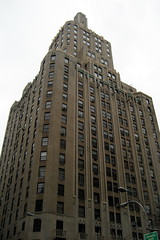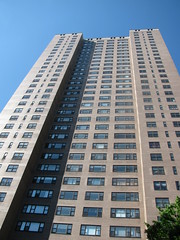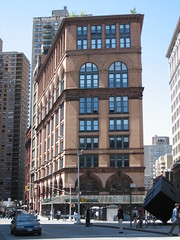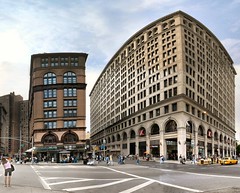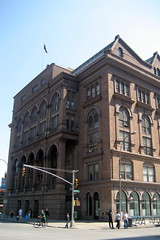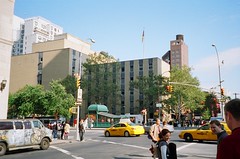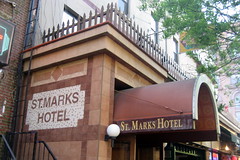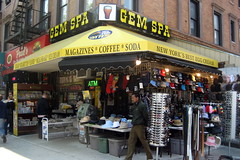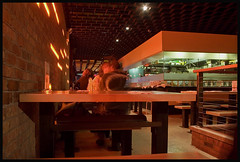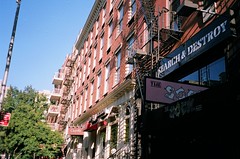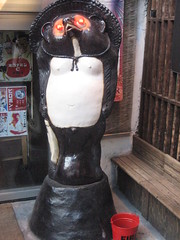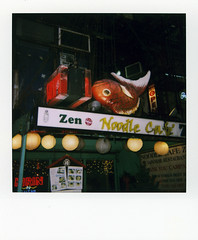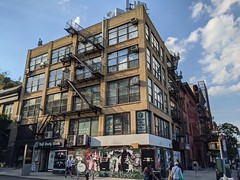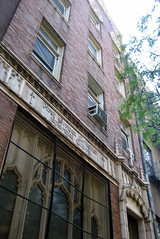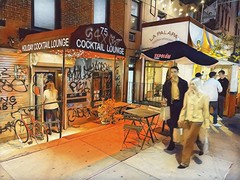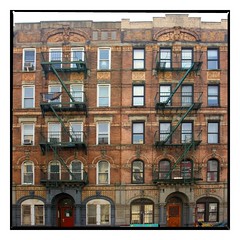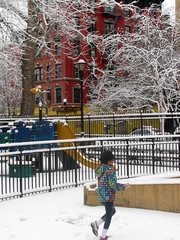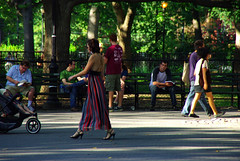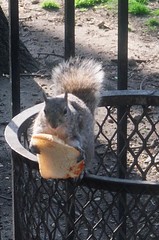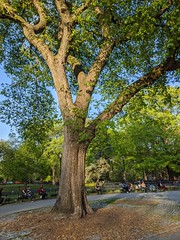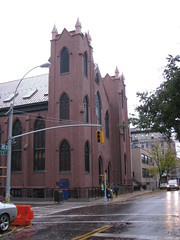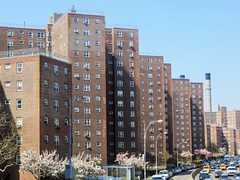South:Corner: The Barnes & Noble here used to be a B. Dalton's. 60: Crown Jewelers 58: Toosh 56: The new home of Economy Foam & Futon, founded on the Lower East Side in 1937 52: Was TLA Video, which stood for Theater of the Living Arts, a company founded by Andre Gregory (of My Dinner With Andre). It's like the Kim's Video of Philadelphia; this was their only New York store. This is also the address of the Independent Theater. The video store was the 8th Street Playhouse, billed as the "first 100 percent cinema" ever. Upstairs, starting in 1933, was the studio of legendary art teacher Hans Hoffman. In the basement is Electric Lady Studios, built by Jimi Hendrix (who lived across the street), used by Rolling Stones, Stevie Wonder (Music of My Mind, Talking Book, Carly Simon, Santana (Supernatural), Kiss (Dressed to Kill, Destroyer), AC/DC (Back in BlackHouses of the Holy), Patti Smith (Horses), Richard Hell (Blank Generation), Blondie (Eat to the Beat), Clash (Sandinista!, Combat Rock), Billy Idol (Rebel Yell), The Roots, Erykah Badu, Daft Punk (Random Access Memories), St. Vincent, Lana Del Rey. The annoying protagonists in Nick and Nora's Infinite Playlist end up here. Was The Village Barn, underground farm-themed club; in the book My Sister Eileen, Ruth and Eileen McKenny took the Brazilian navy here. 50: Insomnia Cookies are open until 3 a.m. 48: Mondini was Enz, shoe store that displayed Sid Vicious' boots. 46: Smoke Shop, head shop formerly known as Magic. 44: No Style clothing 42: Fashion Shoppe Express 40: This hideaway has a long history: In 1929, Village character Romany Marie moved her tearoom here; Buckminster Fuller, a regular, designed the decor for her. Later it was Don Julio's, a Latin dance club, then Bon Soir, a cabaret where Barbra Streisand and Woody Allen performed as unknowns. After that it was Le Jardin, an elite gay club, followed by a bar called W. 8th. After a $2 million makeover, it was a house music club called Love. Now scheduled for demolition, along with everything to the corner of Macdougal. 38 (corner): Cassioppia tattoos and piercing, named (kinda) for Andromeda's mom in Greek myth; Two Toots tobacco shop; Good Sense head shop; Exe'x, rock gear. |
|
|
32: Versailles clothing was 8th Street Bookshop, classic Beat bookstore; Bob Dylan was introduced to Allen Ginsberg here in 1964. Also Paints & Prints. 28: 8th Street Wine Cellar, wine bar; was Todd Walsh Shoes/Mandala Tibetan. Poet Edwin Arlington Robinson lived here from 1922-27. 24-26: Built in 1838 by merchant John W. Alsop, these townhouses were later converted into artists' studios. 26 is Untitled clothing; 24 is Is-Wine, helpful wine shop. 22: Sanmaroo, Korean 20: Butterfly, T-shirts etc. 18: Andy's Chee-Pees, vintage chain founded 1977, was Freaks Lounge, head shop. Philosopher Randolph Bourne died at this address in the 1918 influenza epidemic; Bourne is best remembered for the phrase "war is the health of the state." New York Studio School of Drawing, Painting and Sculpture8-12: The buildings date to 1838, converted to one house and a gallery for Gertrude Vanderbilt Whitney in 1931; it became an early incarnation of the Whitney Museum in 1936. The school was founded in 1964 and moved here shortly thereafter. 4: Here was a stable converted into a gallery by John Taylor Johnston, an early art collector. Two Fifth AvenueThis behemoth, which destroyed the house that inspired Henry James' Washington Square, helped spark Village preservation movement. Former Mayor Ed Koch, feminist politician Bella Abzug and gay writer/activist Larry Kramer have lived here. Fountain to right of front door fed by Minetta Brook, a now-underground river that used to meander through Washington Square Park and the Village. The north end of the block was 8 5th Avenue, the site of New York's first marble mansion, built by John Taylor Johnston in 1856. The Metropolitan Museum of Art was organized here in 1870, with Johnston elected its founding president. Writer/cartoonist James Thurber lived there in 1935-36. On the ground floor now is Brown Harris Stevens, real-estate firm that dates to 1873. |
W
|
North:Gray's Papaya
Corner: Notable hot dogs, tasty and super cheap. 65: Dae Sung Sports Cap & Hat 61: Was Fun House, "Quality Rock 'n' Roll Gear" 57: Saga Shoes (formerly Shoe Central), one of many shoe stores along 8th Street (though many more have shut down, victims of the kind of over-specialization Jane Jacobs describes in The Death and Life of Great American Cities, which she illustrates by talking about, of all places, West 8th Street, whose strip of nonstop restaurants had died because all you could do here was go to a restaurant). 55: Was Skechers—at an address where guitarist Jimi Hendrix supposedly lived in the late 1960s. (This has been disputed.) 53: Enrica Lossi shoes 51: Aliyan clothing 49: Make 10 shoes
45: Desire, bar & grill featuring glowing white jade bar, opened here in 2009. Space was daBhang Cafe, loungey coffeeshop. Upstairs since 1978 or so was Revolver Records, aka Revolution Records, specializing in vinyl LPs, bootlegs, and Beatles memorabilia. Robert Plant supposedly shopped here. Closed around 2005. 43: Mind Boggler shoes. This was Alice McCollister, restaurant noted in the 1939 WPA Guide. 41: Lomography is a store for pre-digital cameras, including the model made by the Soviet firm Lomo. 39: Da Vinci shoes 37: Uncle Sam's Army Navy 35: Was House of Nubian, Afrocentric store. From 1976-84 it was Mamie's ice cream parlor. 33: Elettaria, stylish restaurant/bar named for a kind of cardamom. The first floor and basement were Joel Heller's Eighth Wonder, a groovy 1960s club that hosted bands like Vanilla Fudge and Curtis Knight & the Squires (featuring Jimi Hendrix). Upstairs was Psychedelic Solution Gallery, a founder of the "Indie Gallery" scene. The opening of a Zap Comix show here in 1989 drew over 7,000 people. Earlier it was the 8th Street Gallery, where in 1942 the Audubon Artists, a group whose members have included Andrew Wyeth, Maxfield Parrish, Isabel Bishop and Paul Cadmus, held their first exhibition. 31: From about 1938-65, this was the site of Sam Davis's Delicatessen and Dining Room; Eleanor Roosevelt is said to have been a regular customer. A college paper in 1958 wrote of four "undernourished" students getting the "Student Special" here: "four enormous hunks of salami, dill pickles, mustard and four huge slices of French bread"--all for a total of $1. 29: Smoke Express Underground was Village Shoe Revue; upstairs is L'Impasse, quality slutwear. 27: Petit Peton; people who can distinguish among the many shoe stores on this block seem to like this one. This used to be the site of the Washington Square Book Shop. 25: Sushi Yawa 19: Stylish Shoe is on the site of Three Steps Down, which was a cheap cafeteria for artists and NYU students. The steps, unfortunately, are gone. 17: Was Saga Shoes. This was the address of Mary Louise Cecilia "Texas" Guinan, speakeasy hostess and self-proclaimed "Queen of the Nightclubs." She supposedly had a solid-gold bathtub here. Madonna portrays her in the movie Hello Sucker. 15: Cho-Cho San, Japanese named for the title character of Madame Butterfly, is a successor to Taste of Tokyo, which closed on 13th Street after 29 years. Critic Edmund Wilson lived here in 1916. 11: Eva's Restaurant & Supplements, since 1978 7: Was Rugged Sole shoes Marlton Hotel5: Jack Kerouac wrote Tristessa here; Lenny Bruce stayed here during his obscenity trial (1964). Ecuadoran President Galo Plaza was born here in 1906 (his father was a diplomat). Valerie Solanas was living here when she shot Andy Warhol. Actors from Lillian Gish and John Barrymore to Julie Andrews and Mickey Rourke have called it home. Now a New School dorm. Kinway Shoes on ground floor. 1: A Plus Jewelry Corner: Le Pain Quotidien, bakery chain |
